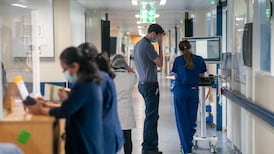Public health officials have advised against people getting Covid-19 tests as reassurance before mixing with family members over Christmas.
“We would not advise that as a protective measure,” assistant chief medical officer Dr Ronan Glynn said, adding that “a test is only as good as the context in which it is taken”.
Some testing companies have said more people are seeking precautionary tests to facilitate get-togethers of families and friends over the festive season.
Hospital Report
However, Dr Glynn said if people want to protect their families or meet people with underlying conditions there are “many other avenues” available to them.
He urged people to keep their network small over the coming weeks, regardless of testing status, and to ensure that anyone with symptoms or who is feeling under the weather does not meet up with others.
The deaths of a further 15 patients with Covid-19 were reported by the National Public Health Emergency Team at its briefing on Thursday. This brings to 2,117 the total number of deaths in the pandemic.
Ten of the deaths occurred in December, officials said.
Confirmed cases
The National Public Health Emergency Team (Nphet) also reported 310 confirmed cases of the disease on Thursday evening, bringing the total number of cases to 75,203.
Prof Philip Nolan, chairman of the Nphet epidemiological modelling advisory group, said the reproduction number is now close to 1 nationally.
Prof Nolan said a “stable point” has been reached in disease trends and the objective from now on would be to keep infections at this level.
The country remained vulnerable while it waited for a vaccine to arrive, he warned.
Hospitalisations are declining slowly, while ICU admissions and deaths are steady, he said. While an average of five patients a day are dying, this would have been 40 a day if restrictions had not been introduced in October.
While there was a narrative that the virus was now less lethal, the data does not support this, he said. Fewer deaths have occurred in the second wave but this was because younger people were becoming infected and long-term residential care facilities were better protected than during the first surge.
Exercising great caution
Despite increases in mobility in the population, this was not yet associated with an increase in close contacts, he noted. This showed that while people were moving about more, they were exercising great caution not to increase their contacts.
There remains a “high risk” of another surge unless the reproduction number is kept close to 1, he said, urging people to remain “extra cautious” and to limit their contacts.
With Christmas a fortnight away, chief medical officer Dr Tony Holohan urged people to plan ahead if they were intending to mix with older or vulnerable relatives by restricting their movements and contacts from now.
Asked if he would be going to a restaurant over Christmas, he said he would not. This was a “discretionary measure” and he wished to minimise his contacts.
The 14-day incidence of the disease now stands at 79 cases per 100,000 people and the five-day moving average at 258 cases a day.
There are currently 202 Covid-19 patients in hospital including 36 in ICU.
Vaccine rollout
The Government-appointed vaccine rollout taskforce is due to submit its plans for consideration by Ministers on Friday. However, Prof Karina Butler, taskforce member and chairwoman of the National Immunisation Advisory Committee, warned that a vaccine was “not a silver bullet” and the public needs to “do all the other things to keep safe”.
“It is important that the encouraging plans for vaccine rollout in 2021 does not distract from the actions we need to take as we face into December 2020,” Dr Glynn said. “A vaccine will have no positive impact on the trajectory of this disease over the coming weeks and does not give immunity to people over the Christmas period.”
We must not allow Covid-19 to spread through our communities now, after all the efforts we have made throughout 2020 and how close we are to beginning to vaccinate.”
On county-by-county breakdown, the latest data shows three of the top five worst areas for the 14-day incidence rate of coronavirus are in Co Donegal, with Carndonagh’s rate more than six times the national average.
The 14-day rate per 100,000 population is a useful measure of how the virus is spreading, and the Government tracks it across the country’s 166 local electoral areas.
Updated figures on the Government’s data hub show the Covid 19 incidence rate in Carndonagh at 518.7 per 100,000 population. The figure in the Inishowen town has more than doubled from last week (271.2) and is almost 6.5 times the national rate of 80.2 per 100,000 population.
Second worst hit for transmission, according to the figures, is Letterkenny, also in Co Donegal, with a rate of 322.2 - up from 288.7 last week after having dipped - followed by Claremorris in Co Mayo, which stands at 257.9.
Callan/Thomastown in Co Kilkenny has a rate of 232.7 while Buncrana, again in Co Donegal, has a rate of 228.










